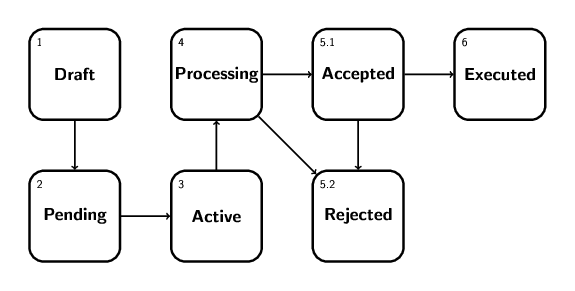Proposals
Table of contents
Decisions in the EffectDAO come from proposals that were approved by Guardians. Right now proposals are meant to distribute DAO funds to initiatives that strengthen the network, but as the governance mechanics mature the DAO will be given more and more control.
EffectDAO is decentralized and opperates completely on-chain. This means that proposals are submitted, voted on, and processed on the EOS blockchain.
The funding for proposals comes from the DAO treasury. The treasury is bootstrapped with a token allocation of 170 million EFX tokens (over 25% of the total supply). To limit the number of tokens that come into circulation over time there is a maximum amount of tokens alleglible per cycle (the budget).
Creating a proposal
All DAO members are able to create proposals. The Effect Dashboard comes with a template that oulines the topics you should normally cover. A proposal costs 100 EFX to create which is meant as protection against spam.
When you first create a proposal it’ll be a draft. This means it’s visible on the dashboard for discussion by other members but it can’t yet be voted on. You can collect feedback and make adjustments for as long as is necessary. As soon as you’re happy with your proposal you can assign it to the next cycle and wait for the voting to start.
So what types of things can you propose? The most useful are requests for funding to get a task done. After such a funding proposal is approved the associated funds can be transferred to the author. It’s also possible to create a proposal that suggests changes to the governance or tokenomics, or that polls a sentiment from the Guardians. These governance proposals often require more development work so they can take a while to be enacted.
Voting on proposals
You can vote on active proposals in the dashboard. There are 3 types of votes you can cast:
- Yes this proposal should be executed.
- Abstain no opinion, let others decide on this one.
- No this proposal shouldn’t get executed.
When you vote your full vote weight is credited to the proposal. It’s recommended to vote on all active proposals in a cycle so you make full use of fee distribution.

Cycles
Although EffectDAO feels like a futuristic machine of AI and automation, it really just is a very fine coordination of people like us, that have jobs, lifes, loved ones, and time-zones to think about. To give all Guardians enough time to anticipate and consider proposals the DAO operates in cycles.
Cycles are fixed time units of 2 weeks in which proposals are reviewed, voted on, and executed. Besides controlling the speed at which proposals can be applied, cycles also have a budget that limits the amount of funds that are released from the treausry.
Proposal lifecycle
A proposal goes through the following stages:
- Draft The proposal is not assigned to a cycle
- Pending The proposal is assigned to a cycle in the future
- Active The proposal is assigned to the current cycle and can be voted
- Processing The proposal was assigned to a past cycle but not yet accepted or rejected
- Accepted / Rejected Votes have been tallied and the proposal is either accepted or rejected.
- Executed The transaction of the porposal has been executed

For a proposal to be approved it needs to:
- Have more Yes votes than No votes
- Have more total votes than the quorum
- Fit within the cycle budget
- Be approved by the High Guard
Recycling of funds
Once a cycle is finished an amount of funds is allocated to accepted proposals. Often there is a an amount of budget left. What happens with this budget is called the recycle strategy. This strategy can always be adjusted by new proposals and consists of 3 segments: funds that go back to the treasury, funds that go to the fee pool, and funds that get burned.